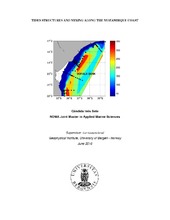| dc.contributor.author | Nhapulo, Candida Ines Sete | eng |
| dc.date.accessioned | 2013-09-05T12:40:25Z | |
| dc.date.available | 2013-09-05T12:40:25Z | |
| dc.date.issued | 2010-06-01 | eng |
| dc.date.submitted | 2010-06-01 | eng |
| dc.identifier.uri | https://hdl.handle.net/1956/7062 | |
| dc.description.abstract | The resolution of environment problems suggests the study of tidal structures and mixing along the Mozambique Coast. Sofala Bank is the area with more available information for this study. Tides along the Mozambique Coast are semi-diurnal and tidal amplitudes vary over the year and in some location as Beira, achieve the amplitude of about 3.6 meters. The analysis of water level amplitudes reveals that it varies depending of location along the Mozambique Coast. Beira is the shallowest part of Mozambique Coast and is where the highest water level amplitude and the maximum dominating tidal component (M2) are found. The results indicate that tides along the Mozambican coast are standing waves. The application of the ROMS (Regional Ocean Model System) model results performs well the water level amplitudes. The study of currents shows the presence of stronger tidal current in Beira. The shallow areas along the coast are generally well mixed and around the shelf brake is developed stratification. | en_US |
| dc.format.extent | 2238995 bytes | eng |
| dc.format.mimetype | application/pdf | eng |
| dc.language.iso | eng | eng |
| dc.publisher | The University of Bergen | en_US |
| dc.title | Tides Structures and Mixing along the Mozambique Coast | en_US |
| dc.type | Master thesis | |
| dc.rights.holder | Copyright the author. All rights reserved | en_US |
| dc.description.degree | Master i Meteorologi og oseanografi | en_US |
| dc.description.localcode | MAMN-GEOF | |
| dc.description.localcode | GEOF399 | |
| dc.subject.nus | 756213 | eng |
| fs.subjectcode | GEOF399 | |
